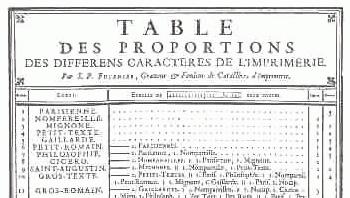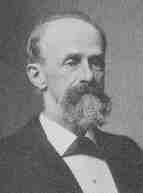|
The history of the American POINT SYSTEM
|
|
| The European connection |
In 1737, Pierre Simon Fournier, a typefounder in Paris, France, published a booklet entitled, "Tables des Proportions qu'il faut observer entre les caractères", announcing his adoption of a typographic point system. The following year he published a type specimen book, in which all the types shown were cast on the point system he invented. Fournier based his point system on the French type size called "cicero", which was 0.1648 of an inch, and he divided his cicero into 12 typographical points.
Fournier was one of the great typefounders in the history of type making. He was a type designer, punch-cutter, typefounder, printer, publisher, and a gifted historian. His monumental work, "Manuel Typographique" was published in two volumes between 1764-1766 in Paris. The work is so exceptional both in quality and contents that it probably never be equalled by anyone, now or in the future.
|
| Ambroise Didot |
After the death of Pierre Simon Fournier, Ambroise Didot, who was an influential typefounder and printer of the period, decided to improve on Fournier's point system by harmonizing it with the existing legal French foot measurement of the day, which was 12.7892 American inches. And so he did. Didot's new thicker point measured 0.0148" compared to Fournier's 0.0137" point. From 1770 on, the Didot typographical point measurement became the accepted European standard¹, and it remains so to this day. Unfortunately for Didot, in 1795 the French government adopted the metric system, thereby divorcing the Didot point system from any legal authority of measurement. C'est la vie!
|
| From Paris to Philadelphia |
The type making equipment purchased by Benjamin Franklin in 1785 included many matrices supplied to him by the son of Pierre Simon Fournier, the inventor of the point system. The Franklin type foundry was sold in 1806 to Binny & Ronaldson, which company continued to function commercially under various names until 1892, when it became one of the principal mergers of the newly created American Type Founders Company. Through this acquisition, ATF also became the owner of a curious set of historical documents. They were the well worn copies of Fournier's "Manuel Typographique", volumes 1 and 2.
|
| The American Connection |
Nelson C. Hawks of Alameda, California (1841-1929) -- a man of great character and personal integrity -- most likely honestly believed that he "invented" the point system. Now, the quality of his historical research, obviously was either very poor or non-existent. On the other hand, it is not unusual in science and technology for different people to independently discover very similar concepts and produce nearly identical results. Fournier's typographic point was 0.0137", Didot's was 0.0148", and the Hawks's American point was set at 0.0138".
During the late 1860s and early 1870s Hawks was personally involved in the printing business and time after time he unsuccessfully tried to convince several companies to change to his point system. It was during his employment with Marder, Luse & Company, as Partner/Manager of the Pacific Type Foundry in San Francisco, that Hawks was finally able to convince A.P. Luse & John Marder to accept and back his point system. The "American System of Interchangeable Type Bodies" was announced in the winter of 1879, and it became an unqualified success. The American printing trade, almost universally, accepted the new point system with astonishing speed. Finally, there was an American standard and typography would never be the same again. Non-pareil, pica, great primer, double pica, three-line pica, and all other unique non-standard sizes, in a very short time, were nothing but history.
|
| The Standard |
In 1886, at the Association of Typefounders of the United States convention in Saratoga, the Hawks's point system was officially adopted as a national standard. By 1892, when the American Type Founders Company was formed, the manufacturing of all non-standard old body types had almost completely ceased. All this change happened predominantly because of the efforts of one individual, Nelson C. Hawks, the man who should be an American legend.
¹In 1879 Hermann Berthold in Germany revised the French Didot point standard to suit the metric system. This Didot-Berthold system was accepted not only in Germany, but much of eastern Europe and Russia. Fabius Library | Fabius Galleries | Fabius Fonts | Great Type Designers | Graphic Designs | Resource Links | Nicholas Fabian Home Page Copyright © 1997- Nicholas Fabian. All rights reserved.  To contact me by E-mail
To contact me by E-mail press the button: ![[E-Mail link]](nfgifs/flashbut.gif)
|
 by Nicholas Fabian
by Nicholas Fabian

 Portrait of Nelson C. Hawks.
Portrait of Nelson C. Hawks.